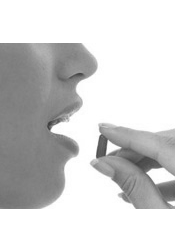pms-Pirfenidone tablets
This product is manufactured by Pharmascience Inc. using the ingredient pirfenidone.
This product is taken orally.

play
orally
Why is it prescribed?
Pirfenidone is indicated for the treatment of mild to moderate idiopathic pulmonary fibrosis (IPF) in adults. Pirfenidone may prevent worsening of the condition and it may improve current lung function.
- It is important to take this medication as your doctor has advised.
- The tablets should be swallowed whole with a full glass of water. They should be taken with food to lessen the chance of stomach upset and dizziness.
- Do not drink grapefruit juice while taking pirfenidone.
- Do not smoke cigarettes while taking this medication. Smoking can reduce its benefits.
- If a dose is missed, the next tablet(s) should be taken as originally planned. Double doses should not be taken to make up for forgotten doses, unless instructed otherwise by your doctor.
- Store this medication at room temperature out of reach of children.
Alternatives
Other products that have the same ingredient as pms-Pirfenidone tablets are •Auro-Pirfenidone tablets •Jamp Pirfenidone capsules •Jamp Pirfenidone tablets •M-Pirfenidone tablets •Sandoz Pirfenidone capsules •Sandoz Pirfenidone tablets •
See other products used in the treatment of •pulmonary fibrosis •
The recommended daily dose of Sandoz Pirfenidone for patients with idiopathic pulmonary fibrosis is 801 mg three times a day with food, for a total dose of 2403 mg/day.
Upon initiating treatment, the dose should be titrated to the recommended daily dose of 2403 mg/ day over a 14-day period to improve tolerability as follows:
- Days 1 to 7: a dose of 267 mg administered, three times a day (801 mg/day) with food
- Days 8 to 14: a dose of 534 mg administered, three times a day (1602 mg/day) with food
- Day 15 onward: a dose of 801 mg administered, three times a day (2403 mg/day) with food
The way that perfenidone works is not fully understood. It may reduce inflammation and fibrosis in the lungs of patients with pulmonary fibrosis. It may prevent worsening of the condition and it may improve lung function.
Along with its benefits, pirfenidone may cause some unwanted effects. The most common side effects include:
- nausea
- dyspepsia
- diarrhea
- vomiting
- fatigue
- weight loss
- dizziness
- rash and increased sensitivity to the sun.
Seek medical attention right away if you experience any of these side effects:
- Severe allergic reactions (rash; hives; itching; difficulty breathing; tightness in the chest; swelling of the mouth, face, lips, or tongue; wheezing)
- chest pain
- severe or persistent diarrhea, nausea, stomach pain or upset, or vomiting
- sunburn
- symptoms of liver problems (eg, bleeding or bruising more easily than normal, dark urine, pale stools, persistent loss of appetite, severe stomach pain, unusual tiredness, yellowing of the eyes or skin).
Do not take pirfenidone:
- If you are allergic to pirfenidone or any of the other ingredients in this medicin
- If you have severe liver disease
- If you have severe kidney disease
- If you are taking:
- fluvoxamine to treat depression and obsessive compulsive disorder (OCD)
Pirfenidone should be prescribed by and supervised by specialist physicians experienced in the diagnosis and treatment of IPF.
Cigarette smoking decreases pirfenidone's effectiveness. Patients should stop smoking before, and not smoke during pirfenidone therapy
Pirfenidone may cause you to become sunburned more easily. Avoid the sun, sunlamps, or tanning booths until you know how you react to pirfenidone. Use a sunscreen or wear protective clothing if you must be outside for more than a short time.
Pirfenidone should be used cautiously in patients with reduced liver or kidney function.
Use in pregnancy: not recommended.
Use in breastfeeding: not recommended
